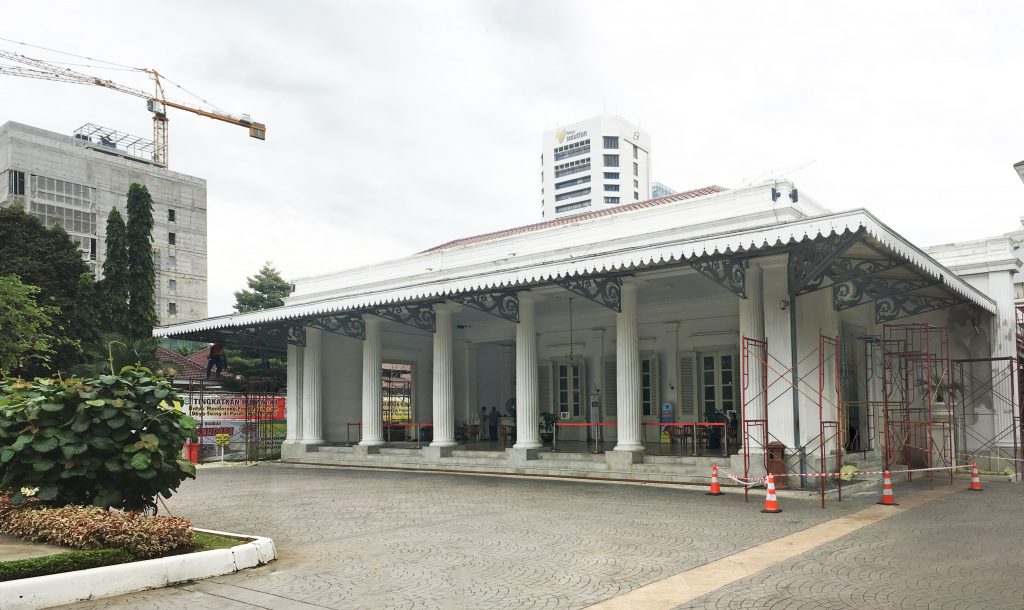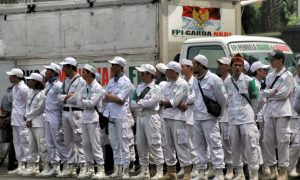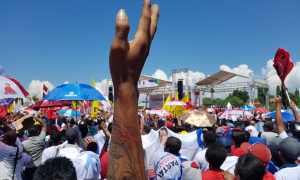How do Jakarta voters assess the policies of their government? Evaluating a public policy involves a complicated process of assessing information and gauging the cost and benefits entailed in the policy. Due to this costly process, most voters prefer to use shortcuts to assess public policy. Among the many shortcuts to use, leader cues might be the easiest one in Jakarta because in this country party positions on issues are not clear.
To investigate the extent to which the Jakarta voters assess public policy using this leader cue, we need to compare the policy support among them in the absence and presence of leader cues. In the absence of leader cues, the only way voters assess the policy is by understanding the information they receive. However, is the information they receive still useful when there is leader cue? Which information is more likely to affect their policy assessment?
To answer these questions, we (Ed: the author is a researcher in the Urban Studies project at Populi Centre) carried out experimental surveys of 600 randomly sampled Jakarta residents in October 2019. In the experiment, we randomly assigned samples into two equal sized treatment and control groups. We maintain balanced characteristics in our samples to avoid biased results (see the graph below).
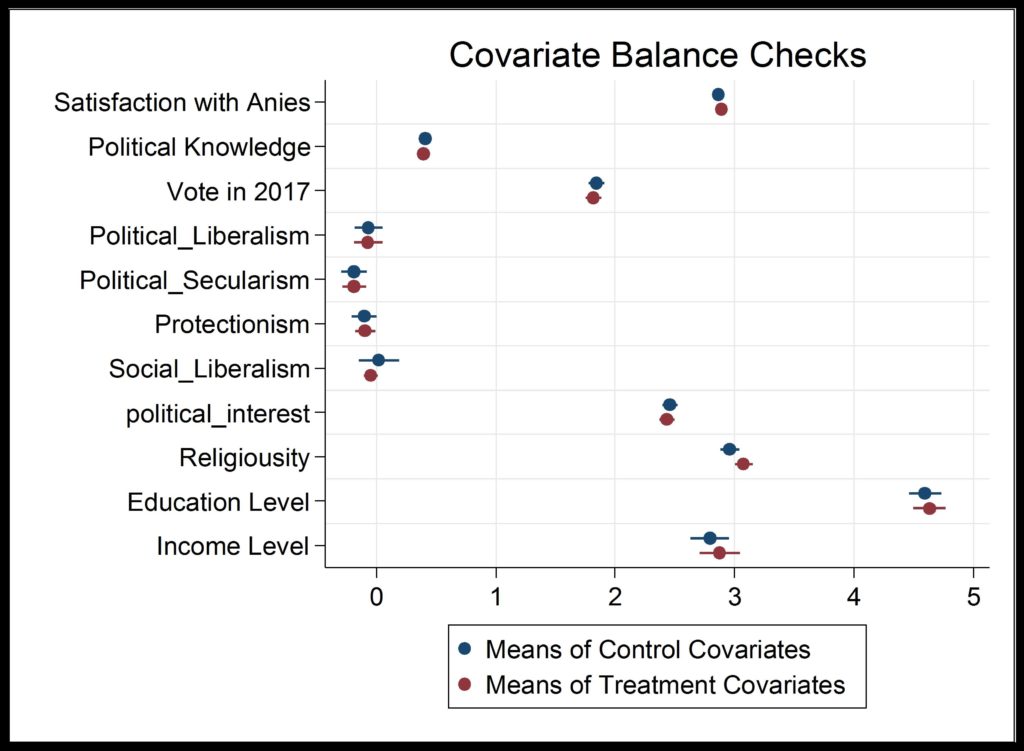
In this short piece, we will demonstrate three policy issues only: flood management policy, Smart Jakarta Card (Kartu Jakarta Pintar), and land reclamation policy.
Jakarta: inequality and the poverty of elite pluralism
Framing Jakarta's election as a referendum on Indonesian pluralism is a way to avoid addressing inequalities of political and economic power.
Control: Flood management program can be done in two ways: first, by widening the river and concretizing the area along the river (concretization). Second, widening the river and planting trees along the river (naturalization). These two programs, however, can entail eviction of people around the river. Yet, the second program might need more lands so that potentially leads to more eviction.
According to your opinion, which program is more appropriate for Jakarta nowadays?
- First program (river widening and concretization); B. Second program (river widening and naturalization)
The exact same question is asked to the treatment group. But this time, we explicitly put the name of the governors initiating the programs: “…during the Ahok era, by widening the river and concretizing… During the Anies era, by widening the river and planting trees…” the answer options also explicitly mention the name of the governors:
According to your opinion, which program is more appropriate for Jakarta nowadays?
- Ahok’s flood management program; B. Anies’s flood management program
The answers provided by the two groups are shown below:
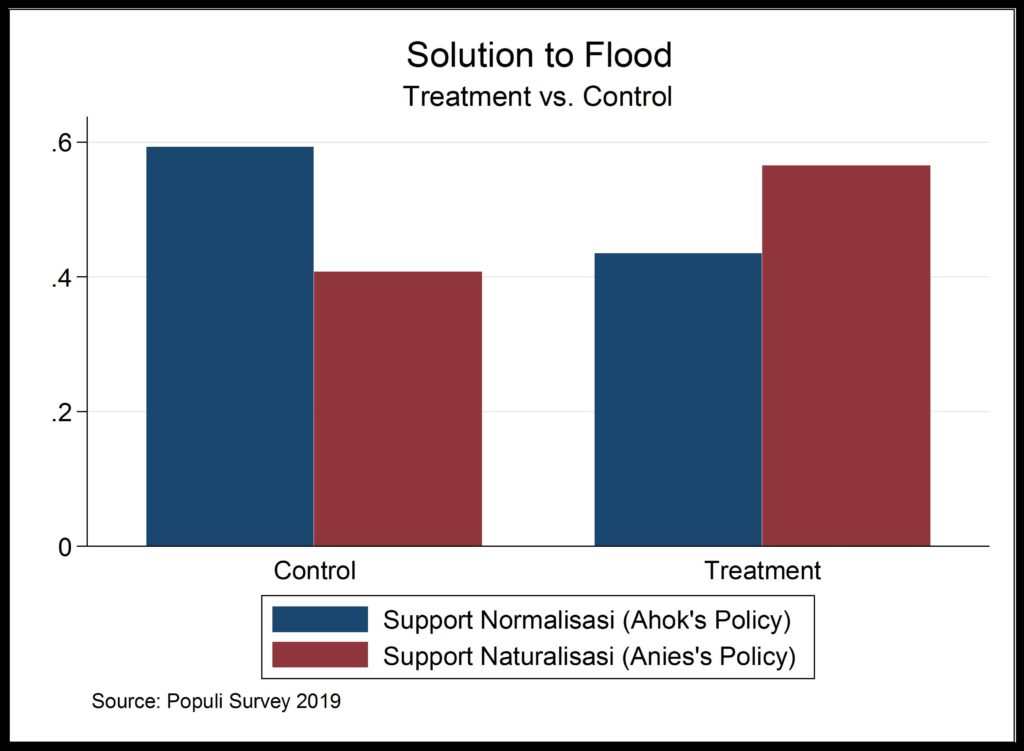
In general, when voters are not informed of who owns the program, they tend to make a good use of the information they receive regarding the cost and benefits of the program. Because the cost of naturalization program (Anies’s program) is greater than that of concretization (Ahok’s program) in terms of land use and eviction, most voters prefer concretization, which means supporting Ahok’s program. However, when they know who initiated and owns the program, support for Anies’s program rises significantly.
One would wonder if the support is affected by whether the respondents are Anies or Ahok’s voters. To test this assumption, we explore the support based on whom these respondents voted in Pilkada 2017. In the absence of leader cues, even Anies’s voters supported Ahok’s flood management policy. However, when there is leader cue, Anies’s voters tend to support Anies’s flood management policy although they know that his program requires more lands and eviction than Ahok’s does (see graph below).

In the second experiment, we ask about the education aid policy commonly known as Kartu Jakarta Pintar (Smart Jakarta Card) or KJP. Here are the questions and answers for both groups:
Control: In your opinion, which educational aid program is more appropriate for Jakarta?
The answers:
- Non-cash transfer to avoid misuse of the aid; B. Bash transfer despite potential misuse of the aid.
Treatment: During the Ahok era, the educational aid program was in the form of non-cash transfers. This is to avoid misuse of the aid. During the Anies era, the educational aid program was in the form of cash transfers. This changes despite the potential misuse of the aid.
In your opinion, which educational aid program is more appropriate for Jakarta?
- Ahok’s educational aid program; B. Anies’s educational aid program
The answers given by the two groups are below:

Notwithstanding the larger support for Ahok’s policy, there is no significant difference in policy support among the respondents in the control group. This might indicate that voters cannot differentiate the benefits of the two programs well. But, when we expose respondents to the governors initiating the program, we observe that support for Anies’s program is substantially higher than that for Ahok’s.
Examining the political support, we observe that both Ahok’s and Anies’s voters tend to support their leaders’ programs. This support is even stronger when they know the governor initiating the programs. This is exhibited in the graph below.
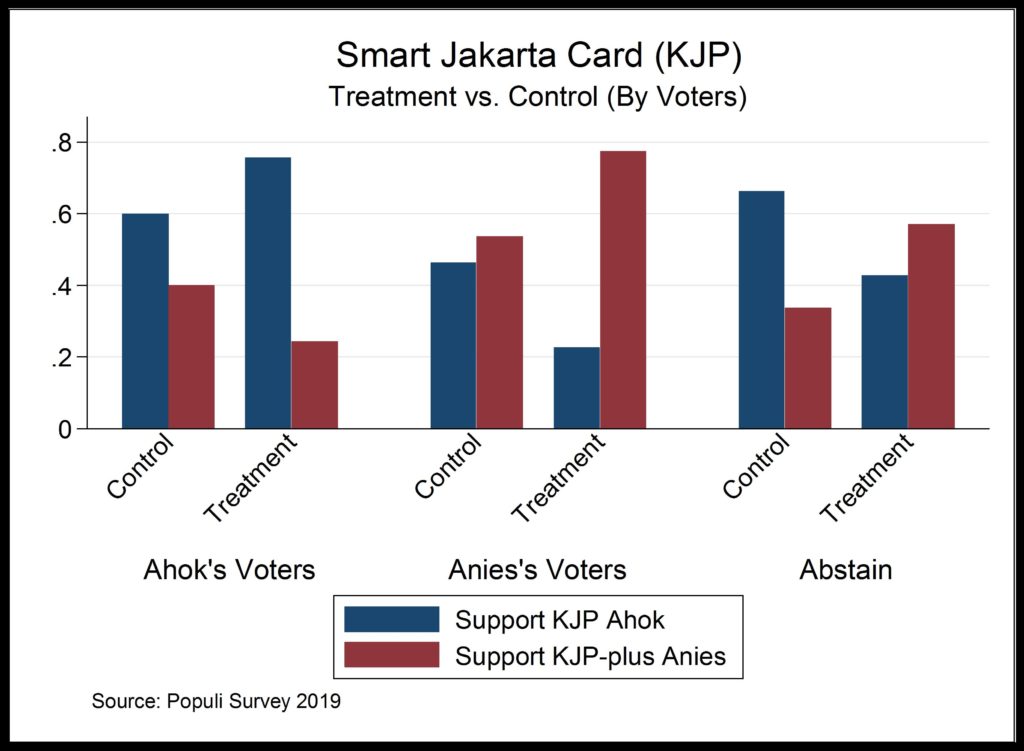
In the third experiment, we explore the land reclamation policy of the two governors. In this experiment, we ask:
Control: In your opinion, which reclamation policy is more appropriate for Jakarta?
Answer:
- Reclamation policy in which the developers are obliged to pay 15%of the prices of the taxable objects (property) for the development of Jakarta.
- Reclamation policy in which the developers are NOT obliged to pay 15% of the prices of the taxable objects (property) for the development of Jakarta
Treatment: During Ahok’s (Basuki Tjahaja Purnama) administration, developers in the reclamation islands were to be obliged to pay 15 % of the prices of the taxable objects (property) for the development of Jakarta. During Anies’s administration, the obligation to pay 15 % of the prices of the taxable objects (property) for the development of Jakarta has been removed. In your opinion, which reclamation policy is more appropriate for Jakarta?
Answer:
- Reclamation Policy in the Ahok’s era; B. Reclamation Policy in the Anies’s era.
The answers provided by respondents are shown below:
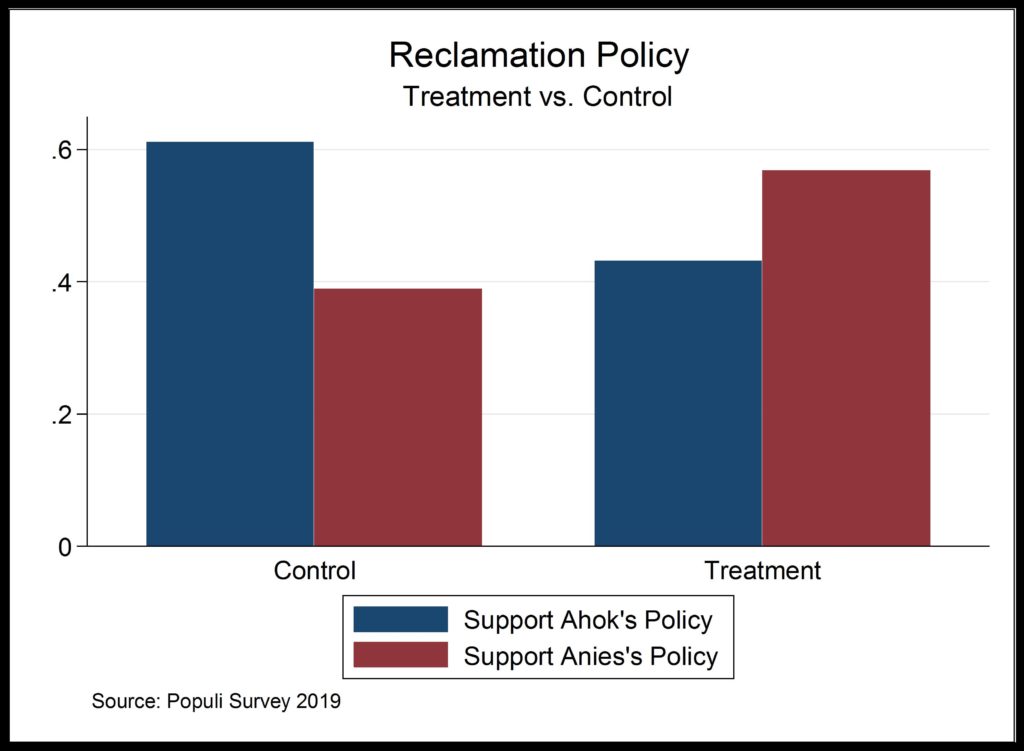
As the chart shows, most respondents not exposed to the governors’ names tend to support reclamation policy with 15% contribution, which is the Ahok’s position. However, when respondents are exposed to the names of the governors initiating the program, most of them support reclamation policy without a 15% contribution (Anies’s position).
Cross-tabulating with the political support, we find that while Ahok’s voters tend to support Ahok’s policy—even without being exposed to information regarding who owns the policy, Anies’s voters tend to support Anies’s policy only when they are informed that the policy were issued by Anies Baswedan. When they did not know the governor behind the policy, Anies’s voters tend to agree with Ahok’s position (chart below).

What can we learn from these results? At least two things stand out. First, leader cues affect voters’ assessment of public policy more than any other information. Exposed to competing information regarding some issues, leader cues tend to outmaneuver other information in the mind of voters. Voters tend to eschew any other information in the presence of leader cues. To some extent, this may indicate that leader cue is the easiest information to digest among other sources of information.
However, the results might also indicate blind loyalty among voters amid increasing trend in political polarization. This can be seen, for example, from the support given by Anies’s voters to his policy. Although voters know the weaknesses of his policy (see some narrations of the questions above), they keep supporting his policies. The attitude of Anies’s voters implies that the personality of Anies is the main factor influencing his voters’ attitude towards public policy issues.
Second, the results also suggest an increasing polarization trend itself in democratizing Indonesia. While previous studies (here and here) find that polarization trends exists on issues related to Islam and politics only, these results point out that polarization branches out into many issues nowadays. However, compared to polarizing trends in many established democracies where partisanship is the driving force, in Indonesia (in Jakarta at least) leaders are the main driver of this trend.
To conclude, as some studies show (including Fossati et al published in New Mandala in mid-2019), leadership still plays important role in Indonesia’s political dynamics. While it is understandable that leader cues provide the easiest and fastest way to understand policy issues, it is quite dangerous to democracy. When voters’ attitude can easily by shaped by a personality rather than rationality, politics becomes more personalized. This can be a negative sign for the democratic process of this country.
 Facebook
Facebook  Twitter
Twitter  Soundcloud
Soundcloud  Youtube
Youtube  Rss
Rss 